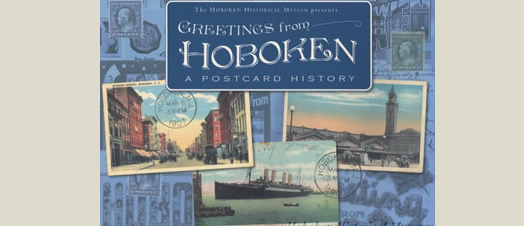Greetings from Hoboken: A Postcard History
January - August 2008

Corresponding with the greatest growth spurt in Hoboken’s history, 1898 – 1930, a simple change in postage from 2 cents to 1 transformed the medium of souvenir postcards into a national craze. Known among collectors as the “Golden Age of Postcards,” the first half of that era, up to roughly the beginning of World War I, gave rise to a flourishing of creativity and communications in an age when mail was delivered twice a day in many urban areas. By 1913, according to Postal Service estimates, some 900 million postcards had been mailed.
Hoboken’s population grew by more than two-thirds over the same period, from 43,000 in 1890 to more than 70,000 by 1910, and many of the city’s public buildings – City Hall, schools, social clubs – and much of the housing stock dates to that era. Fortunately for history buffs, the mania for picture postcards and the spirit of boosterism that pervaded this boomtown resulted in a rich visual documentary record of pre-World War I Hoboken.
Much like today, however, social observers grew alarmed at the rapid rise in popularity of tersely worded correspondence via postcards, voicing concern that it would mean the demise of letter-writing and literacy. John Walker Harrington wrote an essay for the March 1906 edition of American Magazine entitled, “Postal Carditis and some Allied Manias,” in which he bemoaned the fact that the “pasteboard souvenir industry has fattened upon epistolary sloth and collecting manias.”
Hoboken’s history as an immigration gateway contributed to the detailed record we have of the period in the many picture postcards that newcomers would send to their families back home, or on to family and friends in their adopted land. Hoboken was a hub for the postcard trade, with German ships bringing the finest-quality postcards from German printers. One store, Brook’s, at 1118 Washington St., advertised itself as a “headquarters for souvenir postcards.”
Nearly 400 of these brightly colored images are on display in Greetings from Hoboken: A Postcard History, an exhibition of postcards from the Museum’s own collections that presents a lively portrait of a booming young city, proud of its fine homes, new businesses and thriving shipping industry. The Museum’s extensive collection derives primarily from donations and acquisitions from the collections of Director Robert Foster, Trustee Paul Neshamkin, and historian and Museum founder Jim Hans. Accompanying many of the displays are relevant artifacts from Hoboken businesses and landmarks.
The displays are divided into several themes, among them the use of postcards to share news events, with postcards of the famous 1900 pier fire and the engineering marvel of “the Tubes” when the Path system opened in 1908. Others include “view cards,” depicting the city’s amenities and new buildings, and there’s even a selection of homemade postcards used to announce family milestones. Nationwide, the start of WWI put a damper on the postcard craze and left the German printing industry in a shambles. However, as an embarkation point for U.S. troops, Hoboken’s postcard trade continued to flourish, with images of servicemen enjoying the “Hut” – a YMCA-sponsored hangout after federal law closed all taverns within a half-mile of the waterfront.
The exhibit was made possible through a special project grant from the New Jersey Historical Commission, a division of the Department of State, as well as the generous support of our corporate donors, including Applied Companies, John Wiley & Sons, Lobato Floors, Otis Elevator, QualityPro Painters, Union Stone Cleaning & Restoration and Hufnagel Landscaping & Design.
